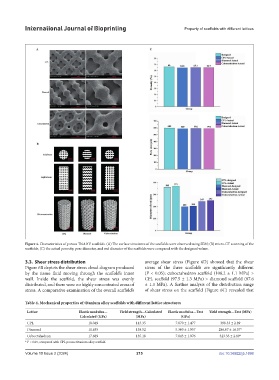Page 223 - IJB-10-2
P. 223
International Journal of Bioprinting Property of scaffolds with different lattices
Figure 4. Characteristics of porous Ti6Al4V scaffolds. (A) The surface structures of the scaffolds were observed using SEM; (B) micro-CT scanning of the
scaffolds; (C) the actual porosity, pore diameter, and rod diameter of the scaffolds were compared with the designed values.
3.3. Shear stress distribution average shear stress (Figure 6D) showed that the shear
Figure 6B depicts the shear stress cloud diagram produced stress of the three scaffolds are significantly different
by the tissue fluid moving through the scaffold’s inner (P < 0.05): cuboctahedron scaffold (108.2 ± 1.1 MPa) >
wall. Inside the scaffold, the shear stress was evenly CPL scaffold (97.5 ± 1.3 MPa) > diamond scaffold (87.6
distributed, and there were no highly concentrated areas of ± 1.3 MPa). A further analysis of the distribution range
stress. A comparative examination of the overall scaffold’s of shear stress on the scaffold (Figure 6C) revealed that
Table 4. Mechanical properties of titanium alloy scaffolds with different lattice structures
Lattice Elastic modulus— Yield strength—Calculated Elastic modulus—Test Yield strength—Test (MPa)
Calculated (GPa) (MPa) (GPa)
CPL 18.049 143.35 7.070 ± 1.477 398.33 ± 2.89
Diamond 11.635 138.52 5.360 ± 1.057 286.67 ± 16.07*
Cuboctahedron 17.689 135.18 7.043 ± 1.076 323.33 ± 2.89*
* P < 0.05, compared with CPL porous titanium alloy scaffold.
Volume 10 Issue 2 (2024) 215 doi: 10.36922/ijb.1698

